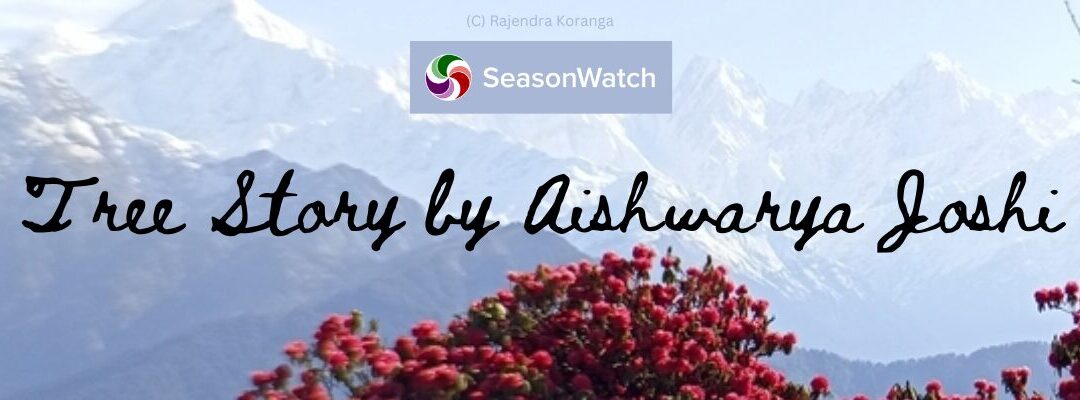The Oak and the Rhododendron is a personal reflection of my childhood preference for the vibrant Rhododendron over the seemingly plain Oak tree (Banj or Quercus leucotrichophora) in Pauri Garhwal. As I grew older and studied ecology, I came to appreciate the Oak’s crucial role in the ecosystem and its significance to the local community’s survival and resilience. This story highlights how the Oak’s quiet strength and enduring importance mirror the steadfast spirit of the people of Uttarakhand.
Since I was a kid, I used to wait for the summer vacations to start as I knew Buransh would be blooming in our village. Ever since I gained consciousness, I have always preferred the fiery red bloom of the Rhododendron to the quiet and sturdy Oak tree in our backyard in a small village in Pauri Garhwal. The dwarf Rhododendron tree, or ‘Buransh’ as we called it, always caught my eye with its vibrant red blossoms, standing against the lush green mountainside. In contrast, the tall Oak that grew close to Buransh seemed plain and unremarkable, a mere backdrop to the more glamorous flora.

As a child, I would run past the Oak without a second glance, my heart set on gathering the vivid red flowers that the Rhododendron offered and tasting its sweet nectar before giving the flowers to my mother to make refreshing homemade squash for the harsh mountain summers. My mother always preferred the boring old Oak tree over the Buransh, and she would often sit under the Oak; she never clearly expressed her fondness for the Oak, but I sensed it as I usually found my mother spending a few stolen moments of leisure sitting under the Oak tree, her hands busy with chores or prayer, and her eyes always full of quiet respect.
Years passed, and our annual summer visits to the village became less frequent. As I delved deeper into my studies, the village and its Oak trees faded from my memory. It was only when I embarked on my journey to study ecology in Dehradun that I truly grasped the silent narrative the Oak had been narrating all along. Oaks, I discovered, were not just trees; they were the lifelines of the Uttarakhand forests. Their presence was not only crucial for the ecosystem but also for the livelihood of the people who relied on them.
After a long hiatus, I returned to my village that summer with a newfound appreciation for the Oak. I sat beside my mother under its broad canopy, feeling the rough bark against my back, and watched the leaves whispering secrets to the wind. The Oak provided so much—its edible acorns could be dried and ground and used to thicken stews or make bread. It is also an important fodder tree. Thus, in times of scarcity, these simple acorns were a source of sustenance for the villagers and their livestock. No wonder the Oak was revered, almost worshipped by the people.

And then there was the Rhododendron, the showy cousin I had adored as a child. I understood the Oak’s silent generosity only through studying the interconnectedness between trees, people and biodiversity. Rhododendrons thrived in Oak forests; without the Oak, there would be no Rhododendrons. The soil enriched by the Oak’s fallen leaves provided the perfect habitat for the Rhododendron’s roots. The Oak, sturdy and dependable, allowed the Rhododendron to shine.

I began to see the Oak in a new light, not as a mere tree but as a symbol of resilience and quiet strength. It stood tall through storms and seasons, its roots deep and unyielding. It wasn’t just a tree but a provider, protector, and silent guardian of the forest and the people.
My mother, wise in her quiet way, had always known what took me years to understand. The Oak, with its unassuming presence, was a testament to the enduring spirit of our land. It was not about the flamboyant beauty of the Rhododendron but about the steadfast, life-giving essence of the Oak.
Sitting there, I realized that the Oak tree was understated but central. It wasn’t just part of the landscape but a cornerstone of our existence. In its branches, I saw the essence of our people, a rich history filled with stories of survival and reverence, and an everlasting promise of life continuing amidst the mountains.
The next time I walked through the forest, I gave the Oak more than just a glance. I touched its bark, felt the strength it had gathered over the years, and whispered a silent thank you. The Oak had always been there, silently supporting me, just like my mother and our ancestors. Then, I truly understood why the Oak was not just a tree but a symbol of our survival, resilience, and quiet strength.
All photos by Aishwarya Joshi.
About the author: Aishwarya Joshi was born and raised in Noida but traces her roots to the picturesque Garhwal region of the Himalayas. As a development professional and ecologist, she is passionate about fostering climate-resilient and sustainable livelihoods for vulnerable communities. She holds a bachelor’s degree in Zoology from Gargi College, University of Delhi, a master’s degree in Environment Management from the Forest Research Institute, Dehradun, and a postgraduate diploma in Rural Management from the Institute of Rural Management Anand.






A beautiful piece which makes for a wonderful read.
A heart warming tale of a gentle giant and the beautiful princess.
What a wonderful snapshot of two iconic trees from the Himalayas!